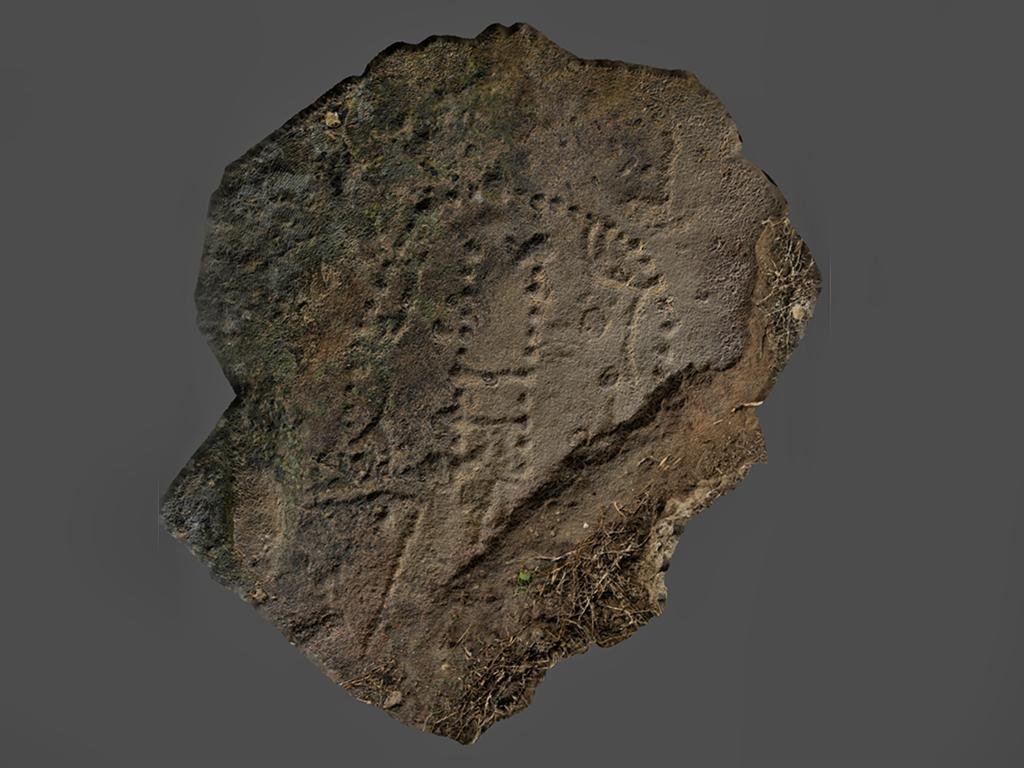A new archaeological study has raised intriguing questions about the origins of one of the world’s oldest known board games, “Hounds and Jackals,” also called the “Game of 58 Holes.” Traditionally believed to have originated in ancient Egypt, recent discoveries on the Absheron Peninsula in Azerbaijan suggest the game may have actually emerged in southwestern Asia, casting doubt on previous ᴀssumptions.
 The fifty-eight holes board from Çapmalı. Credit: Crist W, Abdullayev R., European Journal of Archaeology (2024)
The fifty-eight holes board from Çapmalı. Credit: Crist W, Abdullayev R., European Journal of Archaeology (2024)
In 2018, archaeologists uncovered ancient game boards on the Absheron Peninsula, located in present-day Azerbaijan. These game boards date back to the late third to early second millennium BCE, making them among the oldest examples of the Game of 58 Holes. The game boards were found at several archaeological sites, including Çapmalı in the Gobustan National Reserve near the Caspian Sea, as well as Yeni Türkan, Dübəndi, and Ağdaşdüzü. The Çapmalı site, in particular, yielded a well-preserved board carved into a rock within a shelter covered in Bronze Age petroglyphs, indicating the site was occupied for millennia.
According to Walter Crist and Rahman Abdullayev, the archaeologists behind the study published in the European Journal of Archaeology, the discovery of these game boards suggests that the Game of 58 Holes was widespread in the region during the Middle Bronze Age, much earlier than its known presence in Egypt. “The diversity of the 58 holes board in southwestern Asia—as well as its early appearance and longevity there—offers a stronger case for an origin further north than Egypt,” they wrote.
The Game of 58 Holes, sometimes called “Hounds and Jackals” due to some gaming pieces resembling these animals, features a distinctive board with 58 holes arranged in two parallel rows of ten, surrounded by an arc of 38 holes. Players moved their pieces along this path, navigating marked or connected holes that likely represented complex game rules. The game was played across a vast region, with examples found in Egypt, the Levant, Mesopotamia, Iran, and Anatolia. This widespread presence had led many scholars to previously believe that the game originated in Egypt during the second millennium BCE.
 Game of fifty-eight holes board from Tomb 312 at el-Asasif, Egypt. 11th Dynasty. Credit: Metropolitan Museum of Art, CC0 1.0
Game of fifty-eight holes board from Tomb 312 at el-Asasif, Egypt. 11th Dynasty. Credit: Metropolitan Museum of Art, CC0 1.0
The earliest known Egyptian example of the game was discovered in a tomb near Luxor, dating from the reign of MentuH๏τep II between roughly 2060 and 2009 BCE. Other versions of the game have been found in ancient Mesopotamia, the Levant, and Anatolia, further complicating the narrative of its origins. However, the new findings from Azerbaijan suggest that the game might have been developed independently in multiple locations or spread rapidly through trade and cultural exchange.
The discovery of game boards in Azerbaijan predating the known Egyptian examples has significant implications for understanding the cultural and commercial interactions in the ancient world. The study authors propose that these findings indicate a more complex network of cultural exchange, where games like the Game of 58 Holes served as “social lubricants” that facilitated interactions and relationships between different cultures.
The research highlights the role of games in ancient societies, not only as a form of entertainment but also as a means of cultural exchange and social bonding. The spread of the Game of 58 Holes across diverse regions suggests that it was quickly adopted by various cultures, who adapted it to their own social contexts. This adaptability and widespread appeal make it difficult to attribute the invention of the game to any single culture or region definitively.
The findings from the Absheron Peninsula suggest that this region was not an isolated backwater but part of a broader cultural network that connected the peoples of the Caucasus with civilizations to the south, including Iran, Mesopotamia and Egypt. The analysis of pottery and other artifacts from the sites supports the idea of seasonal occupation by pastoral communities, indicating that these game boards were likely used by shepherds during the winter months when they settled in shelters like those found at Gobustan.
Crist and Abdullayev caution against jumping to conclusions about the game’s exact origins. “While the evidence from Azerbaijan is compelling, it is important not to rush to attribute the invention of the game to any single culture,” they note. The discovery of these ancient game boards in southwestern Asia suggests that the game may have developed in multiple locations simultaneously or was transmitted quickly through existing cultural networks.
More information: Crist W, Abdullayev R. (2024). Herding with the Hounds: The Game of Fifty-eight Holes in the Abşeron Peninsula. European Journal of Archaeology:1-20. doi:10.1017/eaa.2024.24





